One week after the election, Trump offered 4-star Army General Jack Keane the position of Secretary of Defense. Keane turned him down (sick wife) but recommended Jim Mattis, also known as “Mad Dog” and “Chaos” and “the warrior monk.
Trump was warned by Keane before offering the job to Mattis that “Mistakes on the domestic side have a correcting mechanism. You can have a do-over. There are no do-overs in national security. When we make mistakes it has huge consequences. By our actions or lack of actions we can actually destabilize parts of the world and cause enormous problems.” Keane felt Obama had been too timid in international policy decisions with Leon Panetta as Secretary of Defense.
Keane spoke with Mattis to make sure he’d take the Secretary of Defense job, if it were offered, and the retired 4-star Marine general had another thing going for him. Obama had fired him in the Middle East in 2013 because Obama thought he was too hawkish and too eager to confront Iran militarily. Obviously, given Trump’s obsession with undoing everything and anything Obama had begun, Mattis would be a good choice to please Trump.
But on another level Mattis might not “fit” because although he was very experienced in the Middle East and an experienced combat veteran, according to Keane: “What’s not obvious is how thoughtful he is and how deliberate he is. He thinks things through. He spends time thinking through the problem.” Essentially, Mattis had devoted his life to the military and had a library of over 7,000 books. His reading habit had given him the nickname “The Warrior Monk.” (*Does this sound like a good fit for Trump?)
Mattis was 66, while Keane was 73. Mattis had written a huge paper on Iran and differed with the previous administration on how best to deal with Iran. He was fearful that Israel would attack Iran and we would be dragged into military conflict in support of Israel.
Mattis to Trump: “We need to change what we are doing. It can’t be a war of attrition. It must be a war of annihilation.” Bannon began calling Mattis “the moral center of gravity of the administration,” although he thought he was too liberal on social policies and a globalist at heart. Bannon began setting up photo ops like those the British P.M. used, where it would show a dignitary coming in or out of #10 Downing Street. The visit of Mattis to the White House to discuss naming him Secretary of Defense would be a great way for Bannon, who came from the world of Breitbart, to manipulate publicity about the administration.
Mattis had taken the Marines into Afghanistan after 911. Mattis worried about the Obama administration’s failure to deter Iran and wrote a thick position paper on what should be done, but it was shredded when he was let go (retired early). Now, with Trump promoting him to Secretary of Defense, everyone wanted a copy of his old notes on dealing with Iran.
One reason Mattis was so hot to face off with Iran was the terrorist bombing of the Marine Barracks in Beirut in 1983 which killed 220 Marines. This was one of the largest single-day death tolls in the history of the Marine Corps. Another 21 died, making it the largest terrorist attack against the U.S. prior to 9/11.
The Donilon Memo was an answer to Mattis and directed that under no circumstances would Mattis take any action against Iran for mining international waters, unless the mine was effectively dropped in the path of a U.S. warship and presented an imminent danger to the ship. Mattis rescinded the Donilon memo the moment he became Secretary of Defense. He continued to talk about how the war plan for Iran was insufficient because it had no joint-force characteristics but depended almost solely on air power. He devised “Strike Option Five,” which was: 1) first against small Iranian boats (2) then against ballistic missiles (3) then against weapons systems and (4) an invasion. Strike Option Five was the plan for destroying the Iranian nuclear program. Mattis had also written a memo to the Chief of Naval Operations that said “the Navy is completely unprepared for conflict in the Persian Gulf.”
When Leon Panetta (Secretary of Defense under Obama) told Mattis that his plan put him at odds with the Obama administration, he said, “I get paid to give my best military advice. They make the policy decisions. I’m not going to change what I think to placate them. If I don’t have their confidence, then I go.”
And go he did, 5 months early, in March of 2013. His draft of strategies focused on confronting and not tolerating Iran’s destabilizing actions through Hezbollah, the Quds Force operations, and their actions in Iraq to undermine the U.S. Did Mattis’ appointment as Secretary of Defense in a hawkish Trump presidency mean a likely military conflict with Iran? (Pray the answer is no!)
Trump was impressed with Rex Tillerson and named him Secretary of State, considered another thumbing of his nose at the Washington political world.

